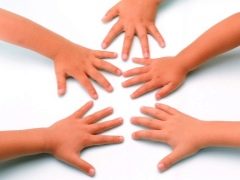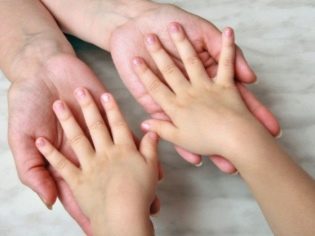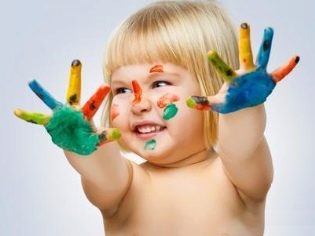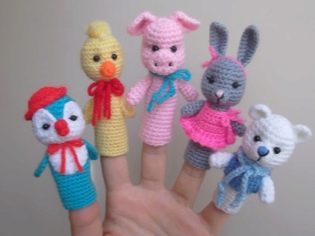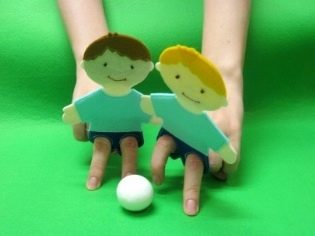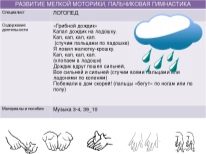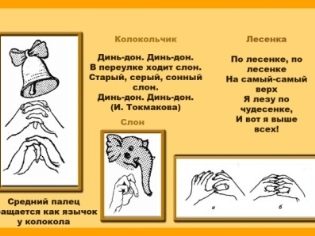Finger gymnastics for children from 2 to 6 years
Many generations of adults play with their babies in the “White-sided Forty” and “The Horned Goat” and do not even realize that they are not just having fun, but are engaged in these minutes with a child of finger gymnastics. Such gymnastics is very useful for the development of speech, creative inclinations, logic and thinking, memory, ability to learn and perception. Classes of fine motor skills stimulate the work of many centers of the cerebral cortex. Finger gymnastics is fun, which is useful and pleasant. How to carry it out for children from 2 to 6 years old, we will tell in this material.
What it is?
Finger gymnastics is an amusing performance of rhymes and counting with the help of fingers. It would seem that there is nothing useful for the health of the child in such games - they only entertain. In fact, this is not the case. At the fingertips there are many biologically active points, the stimulation of which causes a chain reaction of neurons, leading to the stimulation of certain parts of the brain. In addition, the child learns to switch attention, improves coordination and fine motor skills.
During games, children have to pronounce certain words simultaneously with the movements of their fingers, and therefore there is a joint development of the speech center, the vestibular apparatus, the center of thinking and logic. The functionality of the cerebral cortex at the time of occupation is at a height, systematic exercises perfectly develop the baby.
Psychologists, pediatricians and psychotherapists believe that finger gymnastics expands the “horizons”, develops the child’s imagination and imagination, stimulates his orientation in space. In addition, when playing exercises, the development of the hand and fingers is stimulated, which is important for preschoolers, because soon they will have to pick up pencils and a pen, they will have to learn writing.
The founding father of this method is considered to be the Soviet teacher Vasily Sukhomlinsky. It was he who was the first to substantiate and study the effects of finger exercises on the development of children and compiled the first manual on finger gymnastics.
Indications
First of all, finger gymnastics exercises are shown to children with delayed speech development, impaired sound pronunciation, shy and shy children, who literally "lose the gift of speech" for any stress factor. Gymnastics is recommended for children who are lagging behind in psycho-emotional development, and also do not know how to express their feelings. The exercises will be useful for children suffering from frequent tantrums, neurosis, hypermobile and hyperactive children who find it very difficult to concentrate on something.
Finger training is recommended for all babies, without exception, from the age of 5-6 months. Such games will help parents avoid many problems in the development of crumbs. With age, exercise becomes more complex and more active. But first of all, such games for children are just fun leisure activities, joint activities with mom or dad, which create an excellent emotional attitude, help in establishing trusting relationships between adults and children.
Where and how to do?
Finger gymnastics is convenient because you can do it anytime, anywhere: at home, on the street during a walk, on the way to kindergarten, on public transport, in kindergarten.Quite often, in preschool educational institutions, elements of finger gymnastics are combined with articulatory gymnastics. This is especially important for preschoolers of 4–5 years old and 6–7 years old - pupils of the senior and preparatory group.
Finger exercises are widespread in the program of children's educational studios and circles, especially schools and studios of early development, which are attended by preschool children from the youngest, secondary to preparatory groups. For mentally retarded children who have certain diagnoses and who are in a dispensary with a psychiatrist and a neurologist, exercises with elements of finger games are conducted by correctional teachers and physical therapy exercises, but mother can also play with the child herself.
For newborns, finger gymnastics may be limited to the development of tactile sensations that the baby receives when it comes into contact with new objects, toys, during daily massage, if the mother does not forget to massage the fingers and palms of the child.
For young children from six months to 2-3 years, the stimulation of speech centers is especially important, and therefore classes are of great developmental importance.
Special didactic material for such gymnastics is not required. In order to make the classes interesting and as useful as possible, you will need everything that you can find in your closet or on the balcony: buttons, nutshells, any prickly and pimply objects, corks, fir cones, a broken keyboard from a computer, various caps, plasticine, clothespins, rope and so on. Everything that has an texture to the touch is an excellent material for practice.
It is better to begin each occupation with easy warm-up for brushes. Massage your child's hands with your fingers, stroke each finger, and stroke your palms in circular motions. The hands of the baby should be warm, and the nerve receptors should be more susceptible to subsequent exercises. If the child is already more than 3 years old, he may well make a self-massage - stretch his fingers and palms on his own.
Finger exercises can be done any number of times a day. Gymnastics has no contraindications. Even lying in bed with the temperature, the child may well want to show any fairy tale with her mom or stage a rhyme. This will help keep him in bed if the doctor prescribed bed rest, as well as entertain the child.
Types of exercises
Like the exercises of other gymnastic complexes, the fingers are conventionally divided into static and dynamic. The first ones imply the ability to place fingers in a certain order, to keep the “constructions” folded out of them. The latter are aimed at quickly changing the position of the fingers, at developing precision and reaction.
Exercises have their age "qualification". It is unlikely that those who really like children in 2-3 years, will be interesting and useful for a child in 5 years, and therefore, planning a program of classes with a child, pay attention to age recommendations.
Classes with a child of 2-3 years
The most popular and familiar exercise for the youngest is the same “Forty-white-sided” who cooked porridge, distributed it to children and cheated on one. It is done very simply: the mother leads the index finger of one of the baby’s hands in the center of the palm of the second, and then (on the porridge distribution) bends the fingers alternately (“this gave, this gave, but this was not”).
At an early age it is very important that the exercises are not only entertaining, but also develop the muscles of the baby. There are a number of tasks that will help in the formation of the elastic muscles of the hand, forearm and shoulder.
- "Rain". Take a small toy figure, a chocolate egg surprise toy will do. Explain to the child that his pen is a house in which a toy can hide if it starts to rain. Ask the child to spread his fingers as wide as possible, to stretch his palm, place a toy in the center of the palm.At the command: “Rain!” The child closes the palm, squeezes the fingers and hides the toy. Fingers of the second hand (mother controls it) start tapping on the clamped cam: “The drip-drip-drip knocks water, the rain comes all day. Toys hid in the house, the rain does not allow them to walk. Tomorrow morning, the sun will rise high-high! ”Gradually, the cam needs to be released, its fingers spread wide as possible, imitating the rays of the sun and raising the handle with the fingers-rays as high as possible.
- "Shaggy friends." You can use a finger theater, or you can just draw on the fingers of a child the faces of animals. They start to bend their fingers with a little finger, listing familiar animals: “Here is a kitten, here is a chicken, here is a little mouse, here is a tiger cub”. When only the thumb remains, they are ridiculously moved from side to side while the others are squeezed, saying: “Who is this such? Dear, good bear! "
- "Kids are sleeping." Tell your baby that his fingers are little children. For clarity, you can "decorate" them with bows or "caps" of fabric or paper, suitable for extreme cases and caps from the bubbles. The child squeezes the fist. Mom reads: “Our children sleep soundly. Peacefully nose sniffle. We will raise them in order to count the children! ”After that, together with the baby, you begin to straighten your fingers, starting with the big one, with the score:“ One, two, three, four, five. Children need a walk. Raise your hand with your fingers extended as high as possible above your head. Then you lower and start to bend them again into the cam, starting with the thumb, with the words: “Quiet, mice, do not make noise, do not wake our children. Will the sun get up, we will play with the children. "
- "Pies". The kid depicts what sculpts the dough, kneads it. In this case, all the fingers on both hands are rhythmically compressed and unclenched, and the hands and wrists work. Mom reads: “We make dough, we knead dough, we will bake pies! And with raspberries, and with viburnum, and cabbage pies. " The child portrays, folding his hands in small boats, the shape of pies, changing hands. Mom reads: “Fragrant pie - our best friend. We’re not going to eat him alone, we will treat everyone in the world! ”Then you can begin to pinch your fingers, listing who the kid would like to treat with patties: father, grandmother, grandfather, brother or sister, a friend from kindergarten, etc.
Gymnastics for 3-4 years
For children at this age, it is important to work on static positions and not to rush. The exercises for this age group themselves become more complex, for example, you can ask your child to show with her hands how a snowdrop blooms in the fairy tale “Twelve months”, how a tulip flower blossoms, how funny a dandelion sticks out. This will develop not only brushes and motor skills, but also figurative thinking.
At 4 years old, a child can easily arrange a finger theater for his mother and younger brothers and sisters; the task of adults is to teach him this. Staging too complex tales at this age is still difficult, but here are some of their fragments or poems - please. You can come up with anything. Consider a few ready-made solutions.
"Offended cat." The child folds his hands like a cat's paws: hiding “claws”, pressing his fingers inside the cam. Mom reads: "Like a cat sat on our window all day long." The child begins to gently unclench and squeeze the cam. This should be done as plastic as possible, with feline grace. Mom continues: "Go away, cat, we want to close the window!". In these words, the small clamps again. “The cat was offended - she showed claws!” With these words, the baby should open her fingers and portray the cat's claws, tensely squeezing her fingers with a bend in each phalanx.
Perhaps this will not happen immediately, but you should not worry - sooner or later, the “claws” will be like real ones.
- "Mosquito". Have the child portray the fingers of a mosquito. To do this, squeezes the cam, then the index finger is lowered onto the table. This will be the proboscis. Next you need to unclench and put on the table the little finger and thumb. Get a mosquito, which sits on the table.The task of the baby is to move your fingers across the table, catch up with her mother's hand and sting with the "proboscis". Mom can hide her hand and even slam a "mosquito." This exercise perfectly develops the muscles of the hand, which will help the child to draw, sculpt and master the letter easier.
- "New Year". Show in this verse need every action:
- “The New Year is inaudible (the child shows snowing, adds snowflakes with his fingers).
- It is time to decorate the Christmas tree (the baby shows the balls, creating them from the hands and fingers, and shows how they are hung on the Christmas tree).
- Both big and little ones are waiting for miracles and magic (the child shows big, small and “magic”).
- Santa Claus in a hurry with a gift (the child shows the fingers of the walking man and rubs his palms).
- It will be Grandfather cool, we will blow on him, New Year's! ”(The child blows on an imaginary Santa Claus, waving his hands quickly, quickly).
Exercises for 4–6 years
At this age, finger exercises will require not only complex “constructions” of fingers, but also memorization of poetry and counting. Start a new exercise with a slow pace, and when the child remembers everything, gradually speed up the exercise. We offer you to get acquainted with several interesting exercises for this age.
- "Hedgehog". This is a very famous exercise that children like for their dynamics and mobility.
- “A cushion with needles lay under the trees (the child shows the pillow, folding her palms, and then makes a lock of fingers, while sticking her fingers static sideways).
- The pillow lay and ran ”(the child collects his hands in an open lock and quickly moves his fingers).
- "Caterpillar". The story about the caterpillar can be drafted by words, but for the beginning it is recommended to master the basic actions of the caterpillar. The baby's index finger is a caterpillar. The palm of the second hand is a leaf. We read poems, and the child depicts the movements of a caterpillar on a leaflet: “I settled on a piece of paper, nibbled and nibbled all day, our little caterpillar has a small tasty leaf to gnaw. The child folds a cocoon from the palms, the mother continues: “The cocoon, white and beautiful, appeared on the paper early in the morning, so marvelous - what a cocoon in the distance?” the butterfly stopped. "
- "Aquarium". Put your hands and the hands of a child in a bowl of water. Ask him to depict fish, crabs, crayfish, octopus and even a shark. Just washing your hands is quite possible to turn into a fun and useful game for the development of motor skills and thinking.
- "House". This exercise will require quick reaction from the child. It is necessary to show each word of the rhyme at the pace of its reading. Gradually, the poem needs to be read faster and faster, so that the movements also become fast. Let your child show imagination in the image of individual words. “We are building a house, well, we put the walls and the porch, here's the window, here is the attic, from the chimney there is smoke ringing. We will open the window, invite all neighbors, come, come, we will treat you to tea. Tea is hot, fragrant, very tasty and pleasant. ”
At preschool age, you can fake a whole story. The middle and index fingers of the hands create an image of a little man. Two hands - two little men. This makes it possible to put a variety of fairy tales. If you combine efforts with friends, mom, dad, grandmother, then you can put great fairy tales with lots of characters.
The main thing is not only to come up with interesting activities and movements for them, but also to memorize the roles. It will be good if the child learns to memorize both poetry and prose. This will greatly facilitate his schooling.
Useful tips
Books on this topic will help parents learn more about finger gymnastics, as well as finding interesting new exercises based on age-related features:
- O. Ermakova "Finger games for children up to three years old";
- I. Maltsev "Finger games from birth to 3 years";
- O. Novikovskaya "Logorhythm for preschoolers";
- T.Tryavorukova "We play with our mother with our fingers";
- A. Khvostovtsev "Smart pens: fingertips for children from 3 months to 7 years."
Most of these books, if desired, can be found on the Internet. They are presented in simple language, well and colorfully illustrated, can be used both by teachers and kindergarten teachers, and parents at home. Any of these books will be an excellent and useful gift from parents for the day of the educator or March 8.
In the next video you are waiting for finger games for kids.
